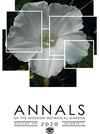中南部和西南部近北区植物特有区
IF 1.3
3区 生物学
Q3 PLANT SCIENCES
引用次数: 0
摘要
在生物地理区划中,对北美中南部/西南部(SC/SW)植物区系的历史和联系进行了研究和总结。然而,一些研究表明,使用定量方法可以更好地确定北美南部/西南部省份的对比划分。通过不同尺度的地方性分析(EA),研究了美国南部/西南部一组植物的空间格局。首先利用iDigBio的数字化标本数据,构建了被子植物61科174属400种、裸子植物2属81965个标本点记录的数据集。然后,我们在四个不同的尺度上进行EA,以确定地方性(AoEs)的区域。在网格大小下选择高分物种数量最多的AoE,得到28个不同细胞大小的AoE。研究区域分裂成两个重要的嵌套或部分重叠的aoe积累中心:西南和南中国海共识区。在新北极地区的这些地区,数据集中的许多属/枝显示出西部和东部枝的地理分裂。这种分裂对应于一种被称为科奇斯过滤器屏障的环境和物理屏障。根据对一些物种的观察,索诺拉-莫哈韦干旱中心、德克萨斯州南部的部分地区和奇瓦瓦沙漠基本上有几个属甚至科的分支分类群,这些分类群允许识别aoe。本文章由计算机程序翻译,如有差异,请以英文原文为准。
Areas of Endemism of Plants in the South-Central and Southwestern Nearctic Region
The history and connections of the flora of south-central/southwestern (SC/SW) North America have been studied and summarized in biogeographic regionalization. However, some studies show contrasting delineations of the SC/SW North American provinces that could be better determined using quantitative methods. We aimed to find spatial patterns of a set of plants in the SC/SW United States by conducting endemicity analysis (EA) on different scales. We first built a dataset with 81,965 specimen point records of 400 species from 174 genera and 61 families of angiosperms and two genera of gymnosperms using digitized specimen data from iDigBio. We then performed EA at four different scales to identify the areas of endemism (AoEs).
We obtained 28 AoEs with different cell sizes by selecting each AoE under the grid size that yielded the highest number of high-scoring species. The study region split into two significant centers of accumulation of nested or partially overlapping AoEs: the SW and SC consensus areas. In these parts of the Nearctic region, many genera/clades, among those in the dataset, showed a geographic split into western and eastern clades. The split corresponded to an environmental and physical barrier known as Cochise Filter Barrier. The Sonora–Mojave arid center, parts of South Texas, and the Chihuahuan Desert harbor basally branching taxa of several genera and even families, based on the observations of some species, which allowed identification of the AoEs.
求助全文
通过发布文献求助,成功后即可免费获取论文全文。
去求助
来源期刊
CiteScore
3.60
自引率
0.00%
发文量
15
期刊介绍:
The Annals of the Missouri Botanical Garden is a quarterly international journal primarily devoted to systematic botany and evolutionary biology. We encourage submissions of original papers dealing with significant advances in the taxonomy, phylogeny, biogeography, paleobiology, and evolution of plants, and in conservation genetics and biology, restoration ecology, and ethnobiology, using morphological and/or molecular characters, field observations, and/or database information. We also welcome reviews and papers on conceptual issues and new methodologies in systematics. Important floristic works will also be considered. Symposium proceedings discussing a broader range of topical biological subjects are also published, typically once a year. All manuscripts are peer-reviewed by qualified and independent reviewers.

 求助内容:
求助内容: 应助结果提醒方式:
应助结果提醒方式:


